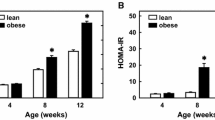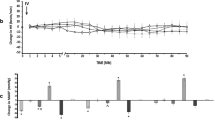Abstract
To evaluate whether the l-arginine-nitric oxide (NO) pathway is involved in the regulation of regional blood flow to brown adipose tissue (BAT), the effects of two specific NO synthase inhibitors, NG-nitro-l-arginine methyl ester (l-NAME) and NG-monomethyl-l-arginine (l-NMMA), on the blood flow to interscapular brown adipose tissue (IBAT) were studied in urethane-anesthetized rats. Regional blood flow in MAT was measured with laser-Doppler flowmetry.
An intravenous injection of l-NAME and l-NMMA, but not of either d-enantiomer, caused a transient and dose-dependent increase in IBAT blood flow. Dose-response curves for these NO synthase inhibitors showed that l-NAME was more potent than l-NMMA in increasing IBAT blood flow. We also observed a concomitant pressor effect accompanied by a slight decrease in heart rate following intravenous injection of l-NAME and l-NMMA. An elevation of IBAT blood flow and blood pressure induced by both l-NAME and l-NMMA was reversed by l-arginine in an enantiomerically specific manner. The increase in IBAT blood flow induced by NO synthase inhibitors was of shorter duration and less sensitive to l-arginine than the increase in blood pressure.
Our results show that the WAY blood flow is increased by inhibition of NO synthase and that the response of IBAT vasculature to NO synthase inhibitors is different from that of the resistance vessels which regulate blood pressure. The involvement of l-arginine-NO pathways in modulating microcirculation in IBAT is suggested.
Similar content being viewed by others
References
Aisaka K, Gross SS, Griffith OW, Levi R (1989) NG-methylarginine, an inhibitor of endothelium-derived nitric oxide synthesis, is a potent pressor agent in the guinea pig: Does nitric oxide regulate blood pressure in vivo? Biochem Biophys Res Commun 160:881–886
Bennett MA, Watt PAC, Thurston H (1992) Endothelium-dependent modulation of resistance vessel contraction: studies with NG-nitro-l-arginine methyl ester and NG-nitro-l-arginine. Br J Pharmacol 107:616–621
Bonner RF, Clem TR, Bowen PD, Bowman RL (1981) Laser-Doppler continuous real-time monitor of pulsatile and mean blood flow in tissue microcirculation. In: Chen S-H, Chu B, Nossal R (eds) Scattering techniques applied to supramolecular and nonequilibrium systems. Plenum Press, New York, pp 685–701
Chilian WM, Layne SM, Eastham CL, Marcus ML (1989) Heterogeneous microvascular coronary α-adrenergic vasoconstriction. Circ Res 64:376–388
Chu A, Chambers DE, Lin C-C, Kuehl WD, Cobb FR (1990) Nitric oxide modulates epicardial coronary basal vasomotor tone in awake dogs. Am J Physiol 258:H1250-H1254
Foster DO, Frydman ML (1979) Tissue distribution of cold-induced thermogenesis in conscious warm- or cold-acclimated rats reevaluated from changes in tissue blood flow: The dominant role of brown adipose tissue in the replacement of shivering by nonshivering thermogenesis. Can J Physiol Pharmacol 57:257–270
Foster DO, Depocas F, Frydman ML (1980) Noradrenaline-induced calorigenesis in warm- and in cold-acclimated rats: relations between concentration of noradrenaline in arterial plasma, blood flow to differently located masses of brown adipose tissue, and calorigenic response. Can J Physiol Pharmacol 58:915–924
Fozard JR, Part M-L (1991) Haemodynamic responses to NG-monom-ethyl-l-arginine in spontaneously hypertensive and normotensive Wistar-Kyoto rats. Br J Pharmacol 102:823–826
Furchgott RF, Zawadzki JV (1980) The obligatory role of endothelial cells in the relaxation of arterial smooth muscle by acetylcholine. Nature 288:373–376
Gardiner SM, Compton AM, Bennett T, Palmer RMJ, Moncada S (1990a) Control of regional blood flow by endothelium-derived nitric oxide. Hypertension 15:486–492
Gardiner SM, Compton AM, Kemp PA, Bennett T (1990b) Regional and cardiac haemodynamic effects of NG-nitro-l-arginine methyl ester in conscious, Long Evans rats. Br J Pharmacol 101:625–631
Gold ME, Wood KS, Buga GM, Byrns RE, Ignarro LJ (1989) l-Arginine causes whereas l-argininosuccinic acid inhibits endothelium-dependent vascular smooth muscle relaxation. Biochem Biophys Res Commun 161:536–543
Griffith TM, Edwards DH, Davies RLI, Harrison TJ, Evans KT (1987) EDRF coordinates the behaviour of vascular resistance vessels. Nature 329:442–445
Hecker M, Mitchell JA, Harris HJ, Katsura M, Thiemermann C, Vane JR (1990) Endothelial cells metabolize NG-monomethyl-l-arginine to l-citrulline and subsequently to l-arginine. Biochem Biophys Res Commun 167:1037–1043
Ignarro LJ (1990) Biosynthesis and metabolism of endothelium-derived nitric oxide. Annu Rev Pharmacol Toxicol 30:535–560
Ishii K, Chang B, Kerwin JF Jr, Huang Z-J, Murad F (1990) Nω-Nitro-l-arginine: a potent inhibitor of endothelium-derived relaxing factor formation. Eur J Pharmacol 176:219–223
Kashima S, Nishihara M, Takemoto Y, Osawa T (1990) Relationship between the integrated intensity of the power spectrum of scattered light and tissue blood volume by the dynamic light scattering method. Jpn J Appl Physics 29:1862–1865
Lahera V, Salom MG, Miranda-Guardiola F, Moncada S, Romero JC (1991) Effects of NG-nitro-l-arginine methyl ester on renal function and blood pressure. Am J Physiol 261:171033–171037
Moncada S, Palmer RMJ, Higgs EA (1989) Biosynthesis of nitric oxide from l-arginine. Biochem Pharmacol 38:1709–1715
Moore PK, al-Swayeh OA, Chong NWS, Evans RA, Gibson A (1990) l-NG-nitro arginine (l-NOARG), a novel, l-arginine-reversible inhibitor of endothelium-dependent vasodilatation in vitro. Br J Pharmacol 99:408–412
Mülsch A, Busse R (1990) NG-nitro-l-arginine (N5-[imino (nitroamino)methyl]-l-ornithine) impairs endothelium-dependent dilations by inhibiting cytosolic nitric oxide synthesis from l-arginine. Naunyn-Schmiedebergs Arch Pharmacol 341:143–147
Nnodim JO, Lever JD (1988) Neural and vascular provision of rat interscapular brown adipose tissue. Am J Anat 182:283–293
Palmer RMJ, Rees DD, Ashton DS, Moncada S (1988) l-Arginine is the physiological precursor for the formation of nitric oxide in endothelium-dependent relaxation. Biochem Biophys Res Commun 153:1251–1256
Rees DD, Palmer RMJ, Hodson HF, Moncada S (1989a) A specific inhibitor of nitric oxide formation from l-arginine attenuates endothelium-dependent relaxation. Br J Pharmacol 96:418–424
Rees DD, Palmer RMJ, Moncada S (1989b) Role of endothelium-derived nitric oxide in the regulation of blood pressure. Proc Natl Acad Sci USA 86:3375–3378
Rees DD, Palmer RMJ, Schulz R, Hodson HF, Moncada S (1990a) Characterization of three inhibitors of endothelial nitric oxide synthase in vitro and in vivo. Br J Pharmacol 101:746–752
Rees DD, Palmer RMJ, Moncada S (1990b) Nitric oxide and the microcirculation. In: Moncada S, Higgs EA (eds) Nitric oxide from l-arginine: a bioregulatory system. Elsevier, Amsterdam, pp 427–437
Richard V, Berdeaux A, la Rochelle CD, Giudicelli J-F (1991) Regional coronary haemodynamic effects of two inhibitors of nitric oxide synthesis in anaesthetized, open-chest dogs. Br J Pharmacol 104: 59–64
Tepperman BL, Whittle BJR (1992) Endogenous nitric oxide and sensory neuropeptides interact in the modulation of the rat gastric microcirculation. Br J Pharmacol 105:171–175
Thiemermann C (1991) Biosynthesis and interaction of endotheliumderived vasoactive mediators. Eicosanoids 4:187–202
Tolins JP, Palmer RMJ, Moncada S, Raij L (1990) Role of endotheliumderived relaxing factor in regulation of renal hemodynamic responses. Am J Physiol 258:H655-H662
Tseng C-M, Goodman LW, Rubin LJ, Tod ML (1993) NG-mono-methyl-l-paradoxically relaxes preconstricted canine intrapulmonary arteries. J Appl Physiol 74:549–558
Uchida Y, Nomoto T (1992) Possible involvement of prostaglandin I2 in modulating blood flow in response to noradrenaline in brown adipose tissue of rats. In: Lomax P, Schönbaum E (eds) Thermoregulation: The pathophysiological basis of clinical disorders. Karger, Basel, pp 143–146
Vallance P, Collier J, Moncada S (1989) Effects of endothelium-derived nitric oxide on peripheral arteriolar tone in man. Lancet 2:997–1000
Whittle BJR, Lopez-Belmonte J, Rees DD (1989) Modulation of the vasodepressor actions of acetylcholine, bradykinin, substance P and endothelin in the rat by a specific inhibitor of nitric oxide formation. Br J Pharmacol 98:646–652
Yang Z, von Segesser L, Bauer E, Stulz P, Turina M, Lüscher TF (1991) Different activation of the endothelial l-arginine and cyclooxygenase pathway in the human internal mammary artery and saphenous vein. Circ Res 68:52–60
Author information
Authors and Affiliations
Additional information
Correspondence to: Y. Uchida at the above address
Rights and permissions
About this article
Cite this article
Uchida, Y., Tsukahara, F., Irie, K. et al. Possible involvement of l-arginine-nitric oxide pathway in modulating regional blood flow to brown adipose tissue of rats. Naunyn-Schmiedeberg's Arch Pharmacol 349, 188–193 (1994). https://doi.org/10.1007/BF00169836
Received:
Accepted:
Issue Date:
DOI: https://doi.org/10.1007/BF00169836




